Marine grade 5052 alloy aluminium sheet plate
features — why choose 5052 for marine applications
- Excellent resistance to seawater and marine atmospheres (better than 3003, 6061 in chloride environments).
- Good fatigue strength and impact resistance for thin-gauge structural components.
- Good formability and moderate work hardening — suitable for bending, flanging and spinning.
- Excellent weldability with common processes (TIG, MIG, resistance).
- Good anodizing response — attractive and protective finishes possible.
- Non-heat-treatable; strength achieved via strain hardening (H1x, H3x, H4x) and temper designations.
- Available in a wide range of thicknesses and widths as sheet and plate.
Typical chemical composition (wt %)
| Element | Symbol | Typical range (%) |
|---|---|---|
| Aluminum | Al | Balance |
| Magnesium | Mg | 2.2 – 2.8 |
| Chromium | Cr | 0.15 – 0.35 |
| Manganese | Mn | ≤ 0.10 |
| Iron | Fe | ≤ 0.40 |
| Silicon | Si | ≤ 0.25 |
| Copper | Cu | ≤ 0.10 |
| Zinc | Zn | ≤ 0.10 |
| Titanium | Ti | ≤ 0.15 |
| Others (each) | — | ≤ 0.05 |
| Others (total) | — | ≤ 0.15 |
Notes:
- The primary alloying element is magnesium; chromium is added to control grain structure and improve corrosion resistance.
- Composition limits are representative of standard 5052 (alloy EN AW-5052 / ASTM B209 / AMS-QQ-A-250 types); specific mill certifications will show exact values.
Common tempers and their implications
| Temper | Condition | Typical property change | Typical uses |
|---|---|---|---|
| O | Annealed | Softest, maximum ductility | Deep drawing, forming |
| H32 | Strain-hardened and stabilized | Medium strength, good formability | General marine panels |
| H34 | Strain-hardened and stabilized to higher strength | Higher strength with some formability loss | Structural components |
| H111 | Slightly work-hardened | Improved strength over O, good formability | Sheet components requiring light forming |
| H112 | Commercially strengthened | Moderate increase in strength | Extruded or cold-worked parts |
Mechanical properties (typical values)
Note: Values vary with temper and thickness. The table shows representative ranges.
| Property | Unit | Typical range (sheet/plate) |
|---|---|---|
| Tensile strength (UTS) | MPa | 215 – 290 |
| Yield strength (0.2% proof) | MPa | 70 – 200 |
| Elongation (A50 or A5) | % | 6 – 20 (dependant on temper and thickness) |
| Hardness (Brinell) | HB | 35 – 70 |
| Density | g/cm³ | 2.68 |
| Modulus of elasticity | GPa | 69 |
| Poisson's ratio | — | 0.33 |
Examples:
- 5052-O (annealed), 1.0 mm: UTS ~ 215 MPa, YS ~ 55–70 MPa, Elongation ~ 20%.
- 5052-H32, 3.0 mm: UTS ~ 240–260 MPa, YS ~ 120–170 MPa, Elongation ~ 8–12%.
Physical properties relevant to marine design
| Property | Value |
|---|---|
| Thermal conductivity (20 °C) | ~ 138 W/m·K |
| Coefficient of thermal expansion (20–100 °C) | ~ 23.8 × 10−6 /°C |
| Melting range | 605–650 °C |
| Electrical resistivity (20 °C) | ~ 0.048 × 10−6 Ω·m |
| Corrosion resistance | Excellent in marine atmospheres and seawater for general applications |
Surface, finish and form options
- Mill finish (standard) — good for welding and painting.
- Polished or buffed finishes — for decorative trim and interior surfaces.
- Anodized finish — improves surface hardness, appearance and corrosion resistance.
- Pre-painted coil/coil-coated — PVDF or polyester paints for long-term protection.
- Alclad or clad options — available in some product lines for enhanced corrosion protection.
- Thicknesses: commonly available from 0.4 mm (thin sheet) up to ~6 mm (plate) in standard production; thicker plates up to 12 mm+ may be available from some mills.
- Widths and lengths: standard coil widths and custom cut lengths; also available as cut-to-size blanks.
Fabrication and joining
- Forming: Excellent cold formability; O temper for deep drawing, H tempers for bending and moderate forming. Use appropriate bend radii to avoid cracking.
- Welding: Easily welded by TIG (GTAW), MIG (GMAW), and resistance welding. Filler metals: typically ER5356 or ER4043 (select according to required corrosion performance and mechanical properties). Pre-weld cleaning recommended to remove oils and oxide.
- Fastening: Compatible with stainless steel and coated fasteners; avoid galvanic corrosion by insulating dissimilar metals where necessary.
- Machining: Good machinability with carbide tools and suitable cutting speeds; chips are ductile so chip evacuation strategies needed.
- Joining considerations: Design joints to avoid crevices and water traps. Use proper sealants and protective coatings in marine environments.
Corrosion resistance and protection
- 5052 shows outstanding resistance to seawater and salt spray compared to many other aluminum alloys due to magnesium content and controlled chromium.
- Susceptible to pitting and crevice corrosion in stagnant saline solutions if protective coatings are damaged; proper coating, anodizing, and design detailing mitigate this risk.
- Cathodic protection and sacrificial anodes commonly used for submerged applications require selection to avoid over-protection or hydrogen embrittlement (rare in aluminum but consider design).
- Avoid direct contact with copper or steel without insulation: galvanic corrosion risk when aluminum is electrically connected to more noble metals in seawater.
Typical marine and related applications
| Application area | Typical components |
|---|---|
| Boat hulls and decks (small craft) | Panels, hull skins, deck sheets |
| Superstructures and pilothouses | Cladding, interior panels |
| Marine equipment and fittings | Tanks, covers, doors, enclosures |
| Offshore platforms & equipment | Walkways, non-critical structural panels |
| Fuel and water tanks | Corrosion-resistant storage vessels |
| Bulkheads and partitions | Lightweight structural panels |
| HVAC and refrigeration ducts | Lightweight ducts exposed to moist environments |
| Transportation (marine-adjacent) | Trailer bodies, truck bodies exposed to road salt |
| Architectural marine-exposed elements | Handrails, exterior panels, canopies |
Notes:
- For primary hull structural members in large vessels, higher-strength alloys and specific structural grades are sometimes preferred; 5052 is generally well-suited for sheet applications, fittings and secondary structures.
Specification references and standards
- ASTM B209 — Standard Specification for Aluminum and Aluminum-Alloy Sheet and Plate
- AMS 4120/AMS 4013 — Applicable aerospace/marine specifications (check specific tempers)
- EN AW-5052 / EN 573 / EN 485 — European alloy designation and product standards
- ISO 6361 — Wrought aluminum and aluminum alloy sheet, strip and plate
Always consult project specifications and mill certificates for exact compliance and test reports.
Selection guidance (quick checklist)
- Corrosion environment: high-salinity maritime → 5052 is a strong candidate.
- Required strength: if higher yield strength needed consider H34 or cold-worked tempers; if deep drawing required choose O or H111.
- Welding required: 5052 is readily weldable; select appropriate filler (ER5356 often preferred).
- Surface finish: choose anodized or painted finish for extended service life and aesthetics.
- Thickness: confirm availability for the thickness required—thin sheet for panelling, thicker plate for stiffer panels.
Storage, handling and maintenance recommendations
- Store flat, dry, and out of direct contact with dissimilar metals.
- Protect from standing water and contaminants to minimize pitting initiation.
- Clean surfaces before painting or adhesive bonding; use compatible primers for marine environments.
- Periodic inspection in marine service: check for crevice or pitting corrosion around fasteners and joints, reapply sealants/paints as needed.
Supplier and quality control notes
- Request mill test certificates (MTC) showing chemical analysis and mechanical properties.
- For critical marine components request sample coupons for corrosion testing where applicable.
- Verify temper and finish per order; e.g., 5052-H32, 1.5 mm, mill finish, cut-to-length.
Marine grade 5052 alloy aluminium sheet plate offers a well-balanced combination of corrosion resistance, formability, weldability and strength that makes it a preferred choice for many marine and saltwater-exposed applications. Selecting the correct temper, finish and fabrication process, along with good design practice to avoid crevices and galvanic couples, ensures long service life and reliable performance in harsh marine environments.
For project-specific recommendations (temper selection, thickness, coatings, welding consumables or sample requests), provide application details (environment, loading, forming requirements, dimensions) and we can recommend the optimal 5052 specification and supply options.
Related Products
Marine 5052 aluminum plate
Marine 5052 Aluminum Plate is noted for its exceptional resistance to corrosion caused by seawater, salt spray, and marine atmospheres.
View DetailsMarine 5083 aluminum plate
Marine 5083 Aluminum Plate belongs to the 5xxx series of aluminum-magnesium alloys and is classified as a non-heat-treatable alloy. Its high magnesium content (typically 4.0–4.9%) enhances its corrosion resistance, especially against seawater-related degradation such as pitting and stress corrosion cracking.
View DetailsMarine 5086 aluminum plate
5086 Aluminum Plate belongs to the 5xxx series of aluminum-magnesium alloys. Its hallmark is a high magnesium content—generally between 4.0% and 4.9%—which delivers enhanced corrosion resistance, particularly against saltwater and marine atmospheric conditions.
View DetailsMarine aluminum steel clad plate
Aluminum / Steel Clad Plates consist of a sandwich construction in which a layer of marine-grade aluminum alloy is metallurgically bonded to a steel substrate.
View DetailsMarine 5383 aluminum plate
The 5383 aluminum alloy belongs to the 5xxx series of aluminum-magnesium alloys known for remarkable resistance to marine corrosion and high strength.
View DetailsMarine 5059 aluminum plate
Marine 5059 Aluminum Plate is distinguished by its high magnesium content and carefully balanced alloying elements, designed to maximize strength without compromising corrosion resistance.
View DetailsRelated Blog
Marine Aluminum Alloy Plate 5052 5083 6061
Marine environments pose extreme challenges—constant exposure to saltwater corrosion, mechanical stresses, and environmental fluctuations demand materials that combine strength, durability, and corrosion resistance.
View DetailsHot Rol 5052 5083 Aluminum Plate Sheet for Boat
When it comes to marine aluminum, hot rolled 5052 and 5083 aluminum plate sheets hold a distinguished place, primarily due to their impeccable blend of strength, corrosion resistance, and formability — factors crucial for boat manufacturing.
View Details5052 H34 Aluminum Plate for Boat
When it comes to marine applications, specifically boat building and repair, selecting the right aluminum material is critical for long-lasting performance, corrosion resistance, and structural integrity.
View Details5052 h111 alloy aluminum marine plate
When it comes to marine aluminum plates, performance and reliability are non-negotiable qualities due to the challenging environments they encounter—saltwater corrosion, fluctuating temperatures, and mechanical stresses.
View DetailsMarine grade 5052 alloy aluminium sheet plate
Features — why choose 5052 for marine applicationsExcellent resistance to seawater and marine atmospheres (better than 3003, 6061 in chloride environments).Good fatigue strength and impact resistance for thin-gauge structural components.
View Details












Leave a Message